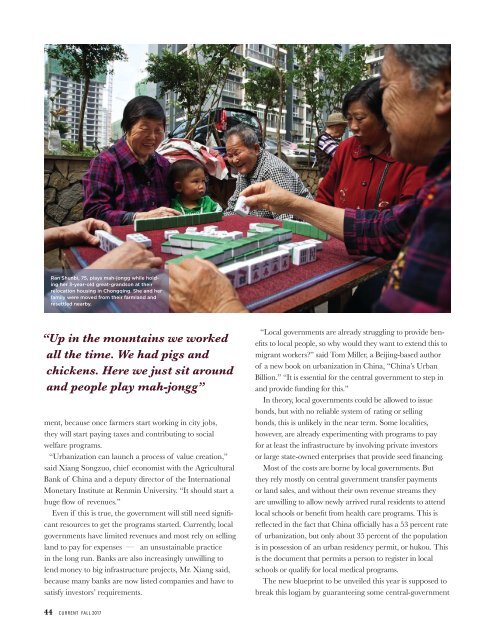Current Magazine
Create successful ePaper yourself
Turn your PDF publications into a flip-book with our unique Google optimized e-Paper software.
Ran Shunbi, 75, plays mah-jongg while holding<br />
her 3-year-old great-grandson at their<br />
relocation housing in Chongqing. She and her<br />
family were moved from their farmland and<br />
resettled nearby.<br />
“Up in the mountains we worked<br />
all the time. We had pigs and<br />
chickens. Here we just sit around<br />
and people play mah-jongg”<br />
ment, because once farmers start working in city jobs,<br />
they will start paying taxes and contributing to social<br />
welfare programs.<br />
“Urbanization can launch a process of value creation,”<br />
said Xiang Songzuo, chief economist with the Agricultural<br />
Bank of China and a deputy director of the International<br />
Monetary Institute at Renmin University. “It should start a<br />
huge flow of revenues.”<br />
Even if this is true, the government will still need significant<br />
resources to get the programs started. <strong>Current</strong>ly, local<br />
governments have limited revenues and most rely on selling<br />
land to pay for expenses — an unsustainable practice<br />
in the long run. Banks are also increasingly unwilling to<br />
lend money to big infrastructure projects, Mr. Xiang said,<br />
because many banks are now listed companies and have to<br />
satisfy investors’ requirements.<br />
“Local governments are already struggling to provide benefits<br />
to local people, so why would they want to extend this to<br />
migrant workers?” said Tom Miller, a Beijing-based author<br />
of a new book on urbanization in China, “China’s Urban<br />
Billion.” “It is essential for the central government to step in<br />
and provide funding for this.”<br />
In theory, local governments could be allowed to issue<br />
bonds, but with no reliable system of rating or selling<br />
bonds, this is unlikely in the near term. Some localities,<br />
however, are already experimenting with programs to pay<br />
for at least the infrastructure by involving private investors<br />
or large state-owned enterprises that provide seed financing.<br />
Most of the costs are borne by local governments. But<br />
they rely mostly on central government transfer payments<br />
or land sales, and without their own revenue streams they<br />
are unwilling to allow newly arrived rural residents to attend<br />
local schools or benefit from health care programs. This is<br />
reflected in the fact that China officially has a 53 percent rate<br />
of urbanization, but only about 35 percent of the population<br />
is in possession of an urban residency permit, or hukou. This<br />
is the document that permits a person to register in local<br />
schools or qualify for local medical programs.<br />
The new blueprint to be unveiled this year is supposed to<br />
break this logjam by guaranteeing some central-government<br />
44 CURRENT FALL 2017





